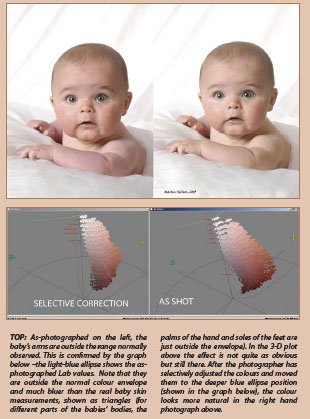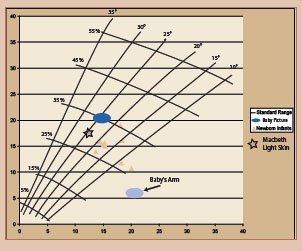articles/Printing/accurateskintone-page7
The Accurate Reproduction Of Skin Tones - part 7 of 1 2 3 4 5 6 7 8
by Mike McNamee Published 01/06/2005

Baby Flesh Tones
We collected data from a study of a large number of babies. In general the values lie on the red side of average for Caucasians with saturations that do not rise above 35%. In Lab
A similar colour-shift effect to that described above has been observed when photographing very young children. Whilst we expect babies to be pink, many digital photographs show an excessive colour change on the forearms (and feet). It is a specific effect as both arms are affected even though they are catching different levels of light. The overall colour shift was too much for a commercial picture, forcing photographer, Martin Sellars, to selectively mask and modify the colour of the arms. As shown in the dual 3-D image, the corrections are quite subtle but make a huge difference to the way the picture looks. In Martin's experience, the problem is specific to digital; no similar issues have arisen in decades of film shooting! Your Editor is presently working with the medical specialists to resolve the puzzle. The consultant dermatologist we questioned was not surprised and provided a cogent explanation of why babies have a higher venous blood flow nearer the surface of their little arms. However whilst babies' arms are undoubtedly bluer, the scale of the effect is at odds with measurements on actual baby skin, as shown in the graph. It seems possible therefore that the greater accuracy of digital is emphasizing an effect, which has previously been masked by the properties of film. Sadly this leaves us with a solution requiring selective (time-consuming) masking. Martin points out that the majority of photographers mistakenly judge the colour to be too magenta which would require an increase in green to correct it. The bias is, in fact, blue and requires an increase in yellow to correct it. Martin adds about 10 points of yellow to the mid-tones and 5 points of yellow to the highlights in the Color Balance dialogue box. This is applied through a selection, feathered about 10 pixels, applied to the arms and using natural folds and shadows to hide the joins. He estimates about 10 seconds to effect the correction.

CorrectionIn the absence of any better advice as to the source of this problem we are currently unable to formulate a rapid solution. Discussions with quite a large number of photographers have shown that the effects described for babies, and the reddening of some adult complexions, are common. One photographer related a situation in which a model was no longer engaged for commissions because her skin always turned orange. Others mentioned the possibility that the UV-screen formulations, commonly built into modern cosmetics, were responsible for some abnormal effects. TV cameramen related that they have selectively filtered particular cameras or lights to improve skin rendering. What is evident is that we have stumbled into an area in which there is a lack of solid evidence. One thing we are sure of - the effect is not that which occurs when the wrong profile is assigned or attached to a digital image. This typically occurs if an sRGB file is moved up into a larger colour space such as Adobe RGB. This produces an overall increase in saturation which is not the effect we are studying, a rotation of the hue angle. Anything which increases saturation will make any hue shift more apparent, so the effects described will seem worse. It is the selective shifts that we are concerned with. We intend to keep hunting!
Please Note:
There is more than one page for this Article.
You are currently on page 7
- The Accurate Reproduction Of Skin Tones page 1
- The Accurate Reproduction Of Skin Tones page 2
- The Accurate Reproduction Of Skin Tones page 3
- The Accurate Reproduction Of Skin Tones page 4
- The Accurate Reproduction Of Skin Tones page 5
- The Accurate Reproduction Of Skin Tones page 6
- The Accurate Reproduction Of Skin Tones page 7
- The Accurate Reproduction Of Skin Tones page 8
1st Published 01/06/2005
last update 09/12/2022 14:50:46
More Printing Articles
There are 16 days to get ready for The Society of Photographers Convention and Trade Show at The Novotel London West, Hammersmith ...
which starts on Wednesday 14th January 2026





